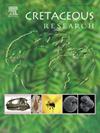The Coniacian sequence in the western Iberian Ranges (Spain): Stratigraphic architecture, systems tracts, biostratigraphy and high-frequency cyclicity
IF 1.7
3区 地球科学
Q1 GEOLOGY
引用次数: 0
Abstract
The Coniacian 3rd-order sequence comprises nine 4th-order parasequences (PsCo1–PsCo9). PsCo1 and PsCo2 are considered a Shelf Margin Wedge as in a Lowstand Systems Tract (LST). Parasequences PsCo3 to the lower part of PsCo6 show an aggradational and retrogradational geometry with onlap on the basal boundary, representing the Transgressive Systems Tract (TST). The upper part of PsCo6 to PsCo9 represents the Highstand Systems Tract (HST) with a Highstand Normal Regression (HNR), upper part of PsCo6 and PsCo7. PsCo8 and PsCo9 show a significative retrogradation of the outer ramp facies and a Forced Regressive Systems Tract (FRST) with progradation of siliciclastic facies from emerged massif on the carbonate facies. The rapid northwards progradation during HST originates a change from a homoclinal ramp to a distally-steepened one. The Coniacian–basal Santonian age is based on the presence of Forresteria (Harleites) petrocoriensis (base of PsCo1) and of Cladoceramus undulatoplicatus (top of PsCo9). Metatissotia ewaldi, Tissotioides hispanicus, Gauthiericeras margae and Prionocycloceras iberiense zones characterize the middle Coniacian. Finally, the late Coniacian is characterised by the Protexanites burgeoisi and Hemitissotia spp. zones. The parasequences are considered to have originated from long eccentricity cycles (0.405 Myr) of Milankovitch's band. Correlation and the reconstruction of the depositional architecture allow quantifying the sedimentary processes and trends, systems tracts, and temporal amplitude of hiatuses. The sequence at the northern outcrops spans 3.65 Myr, and only 0.81 Myr at the southern ones, with most time contained in the hiatuses of the basal (2.43 Myr) and upper (0.405 Myr) sequence boundaries.

西伊比利亚山脉(西班牙)的Coniacian层序:地层构型、体系域、生物地层学和高频旋回
Coniacian三阶序列包括9个四阶副序列(PsCo1-PsCo9)。PsCo1和PsCo2被认为是低水位系统区(LST)中的陆架边缘楔。PsCo3至PsCo6下部的副层序在基底边界上呈现叠加和退积的几何特征,代表了海侵体系域。PsCo6至PsCo9的上半部分为高位正态回归(HNR)的高位系统域(HST), PsCo6和PsCo7的上半部分为高位正态回归(HNR)。PsCo8和PsCo9表现出明显的外斜坡相退退和强迫退退体系域(FRST),并伴有出露地块的硅屑相在碳酸盐相上的退退。HST期间的快速北进源于同斜斜坡向远端陡坡的转变。coniian - basal Santonian年龄是基于forsteria (Harleites) petrocoriensis (PsCo1底部)和Cladoceramus undulatoplicatus (PsCo9顶部)的存在。中部锥虫纪的特征为伊瓦尔变癣、西班牙斑癣、马氏斑癣和伊比利亚斑癣。最后,晚Coniacian以原太古纪资产阶级带和半组织带为特征。准层序被认为起源于米兰科维奇带的长偏心旋回(0.405 Myr)。对比和沉积构型的重建可以量化沉积过程和趋势、体系域和断裂的时间振幅。北露头的层序跨度为3.65 Myr,而南露头的层序跨度仅为0.81 Myr,大部分时间位于基底(2.43 Myr)和上部(0.405 Myr)层序边界的断裂带中。
本文章由计算机程序翻译,如有差异,请以英文原文为准。
求助全文
约1分钟内获得全文
求助全文
来源期刊

Cretaceous Research
地学-地质学
CiteScore
4.10
自引率
19.00%
发文量
235
审稿时长
12 weeks
期刊介绍:
Cretaceous Research provides a forum for the rapid publication of research on all aspects of the Cretaceous Period, including its boundaries with the Jurassic and Palaeogene. Authoritative papers reporting detailed investigations of Cretaceous stratigraphy and palaeontology, studies of regional geology, and reviews of recently published books are complemented by short communications of significant new findings.
Papers submitted to Cretaceous Research should place the research in a broad context, with emphasis placed towards our better understanding of the Cretaceous, that are therefore of interest to the diverse, international readership of the journal. Full length papers that focus solely on a local theme or area will not be accepted for publication; authors of short communications are encouraged to discuss how their findings are of relevance to the Cretaceous on a broad scale.
Research Areas include:
• Regional geology
• Stratigraphy and palaeontology
• Palaeobiology
• Palaeobiogeography
• Palaeoceanography
• Palaeoclimatology
• Evolutionary Palaeoecology
• Geochronology
• Global events.
 求助内容:
求助内容: 应助结果提醒方式:
应助结果提醒方式:


